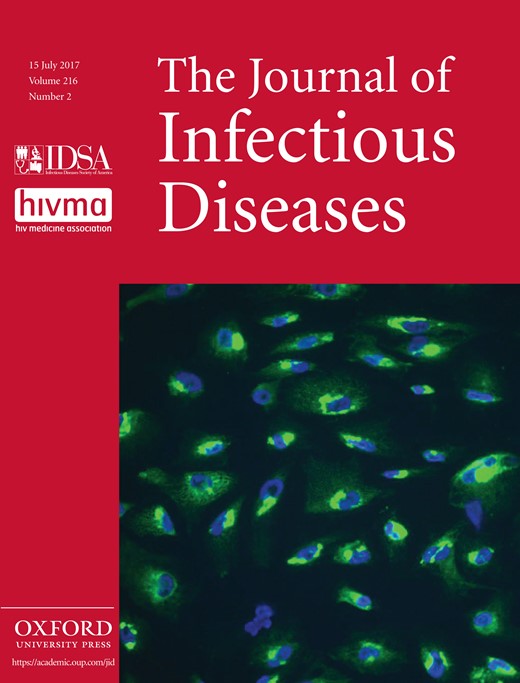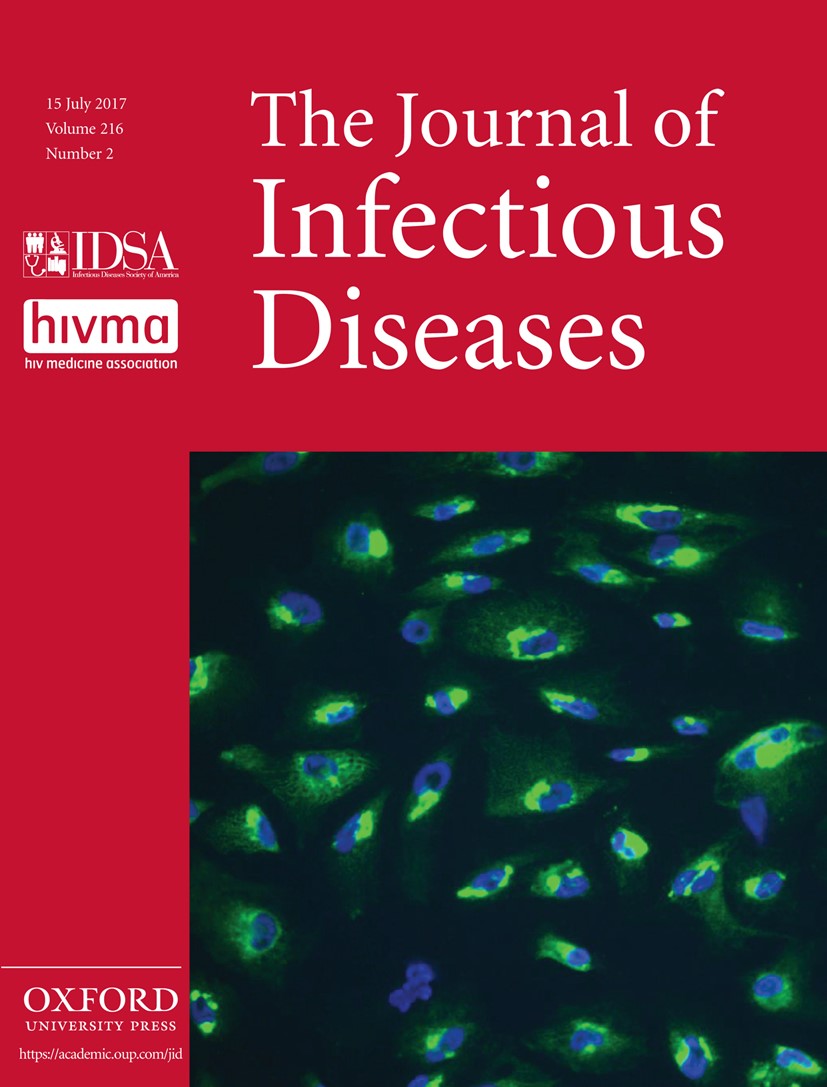
Cover image

Volume 216, Issue 2, 15 July 2017
EDITORIAL COMMENTARIES
Parainfluenza Virus 3–Specific T Cells: Opportunity for Intervention?
Stepping Off the Resistance Treadmill
MAJOR ARTICLES AND BRIEF REPORTS
VIRUSES
Characterizing the Cellular Immune Response to Parainfluenza Virus 3
This manuscript explores the potential of developing a novel immunotherapeutic approach for the prevention/treatment of parainfluenza virus 3 infections by characterizing the cellular immune response to all 7 encoded viral antigens and establishing a hierarchy of immunogenicity
Zika Virus Infection of the Human Glomerular Cells: Implications for Viral Reservoirs and Renal Pathogenesis
Specific Biomarkers Associated With Neurological Complications and Congenital Central Nervous System Abnormalities From Zika Virus–Infected Patients in Brazil
The first systematic large-scale analysis of immune mediators reported in patients with Zika virus (ZIKV) infection. Several key immune mediators have been identified for the control of ZIKV pathogenesis. This will clarify the molecular mechanisms of ZIKV infection in patients.
A Sensitive Method for Detecting Zika Virus Antigen in Patients’ Whole-Blood Specimens as an Alternative Diagnostic Approach
The reemergence of Zika virus (ZIKV) warrants the need to develop complementary diagnostic measures. In this study, flow cytometry was used to determine the presence of ZIKV NS3 antigen in blood monocytes from ZIKV-infected patients
Serum C-Reactive Protein and Congestive Heart Failure as Significant Predictors of Herpes Zoster Vaccine Response in Elderly Nursing Home Residents
The immunogenicity of the varicella-zoster virus vaccine in elderly nursing home residents has an inverse relationship with serum levels of C-reactive protein and heart failure status. Furthermore, heart failure in this population is associated with markers of T-cell immunosenescence.
Valganciclovir for the Suppression of Epstein-Barr Virus Replication
Among 26 asymptomatic men enrolled in a randomized, double-blind, placebo-controlled study, valganciclovir, 900 mg daily, substantially reduced both the proportion of days on which Epstein-Barr virus was detected on oropharyngeal swabs and the quantity of virus present.
Prolonged Shedding of Human Coronavirus in Hematopoietic Cell Transplant Recipients: Risk Factors and Viral Genome Evolution
Prolonged shedding of human coronavirus in hematopoietic cell transplant recipients was associated with initial high viral load, high-dose steroids, and myeloablative conditioning regimens. No substantial intrahost evolution of viral genomes occurred over time.
Health and Economic Impact of a Tender-Based, Sex-Neutral Human Papillomavirus 16/18 Vaccination Program in the Netherlands
Reducing the human papillomavirus burden by vaccinating boys is modestly less efficient than by increasing coverage among girls. Extending vaccination to boys is cost-effective when vaccines are procured through a tendering process, even when the coverage among girls increases to 80%.
Etiology of Severe Acute Watery Diarrhea in Children in the Global Rotavirus Surveillance Network Using Quantitative Polymerase Chain Reaction
We calculated pathogen-specific attributable fractions of acute watery diarrhea in children from 16 countries using quantitative polymerase chain reaction testing for a broad range of enteropathogens. Rotavirus remained the leading etiology, despite a clear impact of rotavirus vaccine introduction.
BACTERIA
White Paper: Developing Antimicrobial Drugs for Resistant Pathogens, Narrow-Spectrum Indications, and Unmet Needs
To meet the need for new pathways to develop antibacterial agents to treat drug-resistant infections, we present feasible trial designs that could enable conduct of narrow-spectrum clinical trials and ultimately approval of critically needed new antibacterial agents.
Genital Chlamydia trachomatis Infections Clear More Slowly in Men Than Women, but Are Less Likely to Become Established
Rigorous estimates for untreated chlamydia clearance rates are important for understanding and controlling infection. We synthesized literature data to investigate clearance in men. Established infections clear more slowly in men than women, and more slowly than had previously been assumed.
Immunotherapy Targeting Adenosine Synthase A Decreases Severity of Staphylococcus aureus Infection in Mouse Model
HIV/AIDS
Human Immunodeficiency Virus Type 1 Persistence Following Systemic Chemotherapy for Malignancy
Systemic chemotherapy for various malignancies leads to long-term increases in CD4+ T-cell–associated HIV-1 RNA and DNA burden in some individuals. HIV-infected cytomegalovirus/Epstein-Barr virus–specific CD4 + T cells may also contribute to maintenance of the HIV DNA reservoir following chemotherapy.
PARASITES
Asian G6PD-Mahidol Reticulocytes Sustain Normal Plasmodium Vivax Development
Functional Analysis Reveals Geographical Variation in Inhibitory Immune Responses Against a Polymorphic Malaria Antigen
Transgenic parasites harboring a naturally-arising polymorphism in PfRh2b reveal no invasion pathway difference but are differentially inhibited by IgG from three endemic regions. Transgenic parasites provide a useful tool to assess specificity of natural or vaccine-induced inhibitory antibodies.
Pyruvate Kinase and Fcγ Receptor Gene Copy Numbers Associated With Malaria Phenotypes
Gene copy number variation (CNV) is associated with phenotypes of numerous diseases, including malaria. A surplus of copies of the PKLR, FCGR2A, FCGR2C, and FCGR3 genes is significantly associated with malaria severity, indicating a role of CNV in host responses to malaria.



